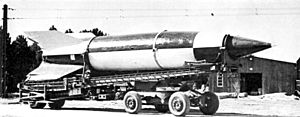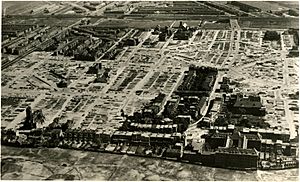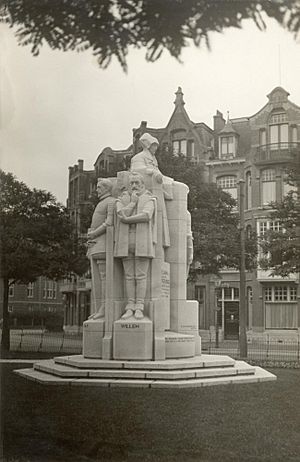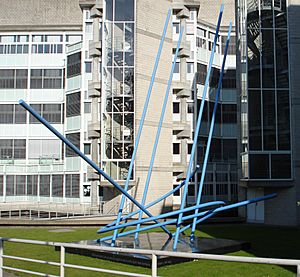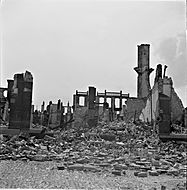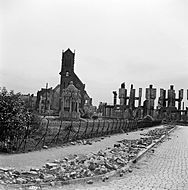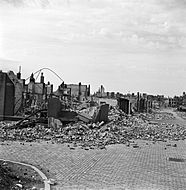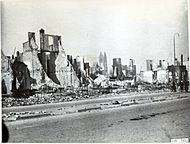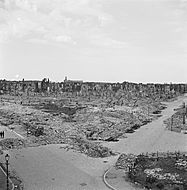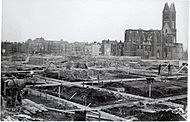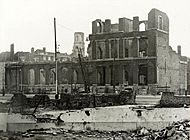Bombing of the Bezuidenhout facts for kids
The bombing of the Bezuidenhout was a sad event that happened on 3 March 1945. During World War II, the Royal Air Force (RAF) accidentally bombed a neighborhood called Bezuidenhout in The Hague, a city in the Netherlands. This terrible mistake led to the deaths of 532 people.
Quick facts for kids Bombing of the Bezuidenhout |
|||||
|---|---|---|---|---|---|
| Part of World War II Operation Crossbow | |||||
 Bezuidenhout burning, shortly after the bombing, photographed from the tower of the Church of James the Greater, at Parkstraat in The Hague |
|||||
|
|||||
| Belligerents | |||||
| Commanders and leaders | |||||
| Air Marshal Sir Arthur Coningham | |||||
| Units involved | |||||
|
|||||
| Strength | |||||
| 56 Boston & Mitchell bombers | |||||
| Casualties and losses | |||||
|
Bezuidenhout civilian casualties (collateral damage):
|
|||||
Contents
Why the Bombing Happened
On 3 March 1945, the British Royal Air Force planned to bomb a forest called Haagse Bos in The Hague. German forces had set up V-2 rocket launchers there. These rockets were being used to attack cities in England.
A Terrible Mistake
Fifty-one British bombers took off from bases in Belgium and France. They carried 67,000 kg of powerful bombs. The pilots were given the wrong map coordinates for their target. This meant their navigation tools were set incorrectly.
Low fog and clouds also made it hard for them to see. Because of these errors, the bombs missed the forest. Instead, they fell on the nearby Bezuidenhout neighborhood. A stronger wind than expected also made the situation worse.
The Impact of the Bombs
At 9:08 in the morning, the bombs hit Bezuidenhout. This caused huge destruction. Many people were already living in the neighborhood. They were evacuees from other parts of The Hague and a nearby town called Wassenaar.
"Everyone went out and into the street. You saw people running, running, running everywhere. But whichever way you ran, there was fire everywhere."
—Survivor
Tens of thousands of people lost their homes. They had to find new places to live in other parts of the Netherlands.
Remembering the Event
The bombing is remembered every year. This happens on the first Sunday after 3 March. People gather to honor those who died. They also remember the bravery of those who helped.
In 2011, the Mayor of The Hague attended the ceremony. Mayors from nearby towns, Wassenaar and Leidschendam-Voorburg, were also there. Their towns had helped with firefighting and caring for survivors. The ceremony included a church service and a concert. A wreath was laid at the Monument of the human mistake.
Facts and Figures
The bombing caused a lot of damage and loss:
- 532 people died.
- 344 people were injured.
- About 30,000 people lost their homes.
- 3,300 homes were completely destroyed.
- 3,250 homes were burned out.
- 3,241 homes were damaged.
- 391 homes were damaged beyond repair.
- 290 businesses were completely destroyed.
- 5 churches were completely destroyed.
- 9 schools were completely destroyed.
- 10 public buildings were completely destroyed.
Images for kids


